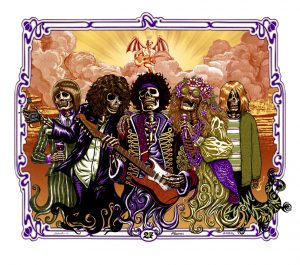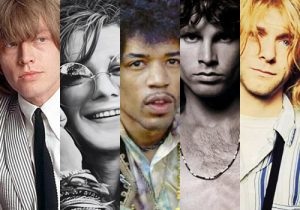Richie Feathers, Arts Editor
It’s no secret that drugs have had irreversible effects on the music industry; so much so that they’ve famously become associated with one another. Regardless of what we’ve continuously been told about the negative effects of drugs, some of the most vital strides in music history have been achieved under the influence of these substances. Would the sonic tapestries of “Sgt. Pepper’s Lonely Hearts Club Band” be nearly as vibrant, or even exist, without the introduction of acid to The Beatles? Would Marvin Gaye’s “What’s Going On” be as remarkably beautiful and relevant as it still is today without its pot-laden production? Could “Rumours” still have accomplished such an iconic level without cocaine adding even more turmoil to Fleetwood Mac’s recording sessions? Luckily, we’ll never have to know.

While that’s certainly not to discredit the master musicians from such significant albums, it can be inferred that it was the drugs that essentially cracked the visionary walls that needed to collapse in order for the true classics to be created. Equally celebrated, there are also countless classic songs that have infamously been inspired by drugs. Some hint at its use (The Beatles’ jaunty “Got to Get You Into My Life”), some unabashedly focus on it (Bob Dylan’s sarcastic “Rainy Day Women #12 & 35”) and others confront it (The Velvet Underground’s stark “Heroin”). There really is no question, drugs have become vastly important to music.
Yet, for all its resulted brilliance, this saturation has also had profoundly negative effects on the music industry. In response, there is a heavy line drawn between listeners who believe in the artistic benefits of musicians on drugs and others who find it difficult to look past the toll that drugs can take on the musicians themselves. Of course, it’s easy to side with the former—when the benefits are good, they can be transcendent. But the latter argument offers its own set of strong testimonials as well, most notably the deaths of countless musicians whose drug use got the best of them.
Although it’s never easy to hear about the death of an artist, it’s even more difficult to face the death of one whose career is just starting, one whose talent beyond their youth promised a bright future. Music’s history is sodden with the loss of these young musicians whose impact in a short period of time was felt, but whose full potential can never be known. Many of these losses continue to be mourned today by multiple generations, a testament to the artists’ influence. However, another reason that the deaths of certain artists are still discussed is one of the greatest mysteries of the music industry: The 27 Club.
Intriguing as many people as it scares, the 27 Club refers to the recurring age at which famous musicians have died. While not wholly linked to drug use, this phenomenon has been widely analyzed and cited by music historians and listeners alike. Between 1970 and 1971, such deaths included Jimi Hendrix, Janis Joplin and Jim Morrison; all drug-related, all 27 years old. Yet, it wasn’t until Kurt Cobain died at 27 in 1994 that the 27 Club became a widely acknowledged theory. The media surrounding Cobain’s suicide was particularly note-worthy for the introduction of this idea as some theorists believed he timed his death intentionally to “join.” Since then, exhibitions have been created, novels written, films directed and plays staged about the 27 Club that currently hosts 45 members.
More recently, in 2011 the immensely talented Amy Winehouse died of alcohol poisoning; she was also only 27 years old. Naturally, attention was once again drawn to the club, especially after she’d expressed fear of dying at that age three years prior.

But despite the eerie circumstances that surround the 27 Club, there really haven’t been any definitive, conclusive correlations between these deaths of so many musicians. Although many have been drug-related, which suggests a predictable result of the sudden spotlight that came to many of the members, the rise to fame and amount of drug use has generally been inconsistent. While Jimi Hendrix, Janis Joplin and Jim Morrison all gained popularity in the mid-60s and had a prior history of drug use, their deaths were similar (accidental overdose) but unrelated. Hendrix’s death was caused by asphyxiation while intoxicated with barbiturates. Joplin died of a heroin overdose, but it’s believed that the dose was laced with something stronger. And Morrison died the following year from heroin he thought was cocaine. As the 1960s offered a completely different drug culture than today, these musicians were victims of their time and perhaps died in spite of their fame, not because of it.
The opposite can be said of Kurt Cobain, who notably struggled with his fame. It’s true, he also abused heroin, which led to his suicide, but Cobain’s death offers contrasting circumstances to the deaths of Hendrix, Joplin and Morrison. That being said, it’s also essential to look at the causes of death of the club’s other members. The Rolling Stones’ founder Brian Jones drowned in 1969, Roger Lee Durham (of Bloodstone) fell off a horse and died of his injuries in 1973 and Big Star’s Chris Bell was killed in a car accident in 1978. Although no less tragic, these deaths suggest the 27 Club was founded based on unparalleled coincidence, not a supernatural menace. Yet, it’s likely that this cautionary unpredictability of the club will still be enough to interest and haunt music fans for generations to come. And the 27 Club will only continue to grow in mystery with time and each new member. It’s an unfortunate and undesirable club to be a part of, yet inevitable when the relationship between drugs and the music industry is so entangled.
Both sides of the argument about musicians on drugs can be strongly presented, though neither can truly be settled. From drug use we may get a masterpiece like “Sgt. Pepper’s,” but for every “Sgt. Pepper’s” we may lose a Kurt Cobain. In the end, it’ll have to come down to how accurate you deem the term “sex, drugs and rock & roll.”
Leave a Reply